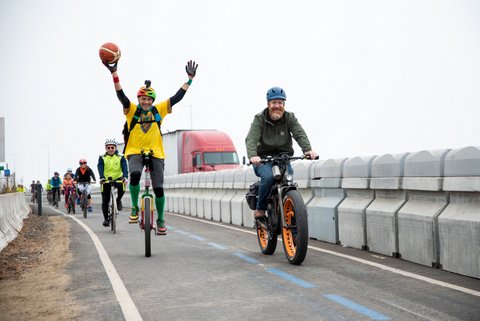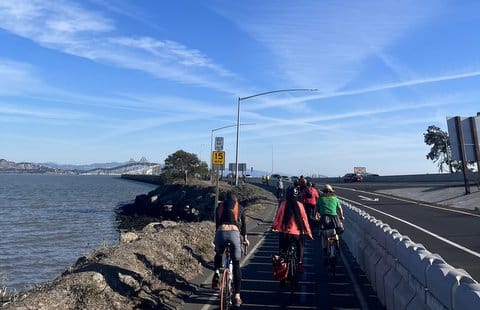
21 Aug Richmond Takes Steps to Curb Traffic Collisions

Dedicated bike lanes, like this one on the Richmond-San Rafael Bridge, with physical buffers separating them from vehicular traffic are one way to protect non-motorists on the road. (David Meza / The CC Pulse file)
By Kelsey Oliver
As Diane Kirkpatrick crossed the intersection of South Garrard Boulevard and East Richmond Avenue to get a coat for her granddaughter, she was hit by a car.
“I just remember my body just feeling soft and just kind of crumbling into it,” Kirkpatrick said of the incident.
Kirkpatrick said she had multiple facial fractures from the April 28 incident. Her cheekbones and nose were broken, one tooth knocked out and other top teeth chipped. In the weeks following the incident, she couldn’t lie down or relax.
“The thing that haunts me too is what if I’d given the keys to my 9-year-old granddaughter and said, ‘Go get it yourself’?” Kirkpatrick said.
Incidents like Kirkpatrick’s are not unusual for the city. During the May 23 City Council meeting, Richmond Police Chief Bisa French said that this year alone, Richmond has had 1,144 traffic collisions. Nineteen of those involved pedestrians.
According to statistics from Richmond’s Local Roadway Safety Plan, a strategy to improve road safety within the city, the total number of collisions resulting in injury in Richmond from 2015-19 was 1,670. Nearly 20% of these involved a bicycle and/or pedestrian.
Though collisions resulting in injury or death have declined in Richmond since the start of the pandemic compared with the recent pre-COVID years, according to collision data from Richmond Police Department, the numbers are still high: 19 fatal collisions and 1,136 collisions resulting in injury from the start of 2020 to July 2023.
French pointed to a few reasons behind such lofty numbers, including the lack of a dedicated traffic unit. Dwindling staff numbers have meant that officers have had to fill patrol beats rather than join the traffic unit. French said that historically, the department has had anywhere from five to 10 officers on the unit. “This is the first year in my 25-year history that we do not have that.”
>>>”People are driving like maniacs,” then-acting Richmond Police Chief Louie Tirona in “Police Adapting to Changing Expectations” (2021)<<<
French said that while some officers are still called traffic officers, they are also responsible for responding to other calls for service. “So they’re not just enforcing traffic issues,” she said. “And in fact, traffic issues are kind of what they do when they have some free time. But calls for service come first,” meanings calls relating to personal injury, shootings, robberies or any other criminal or civil matter that a police officer responds to.
Both the city and community groups are taking steps to improve road safety, including the passage of the Local Roadway Safety Plan in July 2022. According to Deputy Public Works Director and City Engineer Robert Armijo, the plan’s primary goals include reducing the number of collisions that result in serious injury or death, ensuring equitable traffic safety, supporting safe travel for people walking and biking, as well as other improvements to safety. The safety plan also includes countermeasures to address collisions, including improvements to roads and vehicles, safer speed limits and other recommendations (i.e., bike lanes, parking buffers, raised crosswalks and intersection lighting).
While the plan does not provide a specific dollar amount for the overall cost of countermeasures, it does include cost estimates for certain projects (e.g. high-visibility crosswalks). The plan also includes information on funding opportunities such as the Highway Safety Improvement Program and California’s Office of Traffic Safety Grant Program.
The roadway plan works in tandem with Richmond’s Bicycle and Pedestrian Action Plan, which was adopted this year and provides infrastructure improvements for people walking, biking, rolling and driving across Richmond. Improvements include speed limit reductions, traffic circles and other infrastructure that could help curb collisions.
Richmond has faced roadblocks along the way that could delay plans. City Council member Doria Robinson noted some challenges, including filling engineering vacancies within public works and budgets that get delayed if the cost of planning goes up.
In terms of solutions, Robinson said protected bikeways, slower roads and other traffic calming measures like curb extensions are ways to make roads safer, which have also been mentioned in the Roadway Safety Plan.
At the same time, she noted there’s not a “one-stop shop” to resolve traffic safety in Richmond. “You know, you’re not going to have a silver bullet to answer the question.”
Groups including Rich City Rides and the Richmond Bicycle Pedestrian Advisory Committee are also working alongside the city to roll these plans out. For Dani Lanis, who is affiliated with both organizations and who also happens to be Kirkpatrick’s son-in-law, investing in cycling and pedestrian infrastructure goes beyond safety concerns. Lanis said “physical activity heals” and that “neighbors need to be able to move around cities and connect with nature, not just via cars.”
Maria Weatherborne, one of Rich City Ride’s Organizers and an avid Richmond cyclist, also mentioned the perks of biking and walking aside from them being a way to get around. Weatherborne is involved with Coffee Rides, in which cyclists meet Fridays for a bike ride followed by coffee. “Cycling is beautiful,” she said. “It has so many different facets to it. Definitely the active part, but once you get active, you build community.”
One of the city’s priorities in terms of rolling out the LRSP is to tackle traffic calming measures, meant to reduce speeds of motor vehicle traffic. According to City Council member Gayle McLaughlin, $1.2 million has been allocated for 18 priority projects for traffic calming, though cost estimates may have risen.
Robinson also said accountability is a factor in all of this in terms of pushing the needle forward in city planning. “We need that kind of accountability, to make and hold an agreement around moving these things forward,” she said. “This plan can’t sit on the shelf. We actually have to act on it, and we have to be accountable to it.”
Though Kirkpatrick has dealt with issues of PTSD and difficulty sleeping since being hit while crossing an intersection, she is on the upper end of her recovery. When she was hit, she was in the pedestrian crosswalk. Nevertheless, “you can’t ever be too complacent,” Kirkpatrick said while reflecting on the incident. “You have to keep checking your surroundings at all times. I learned that.”






No Comments